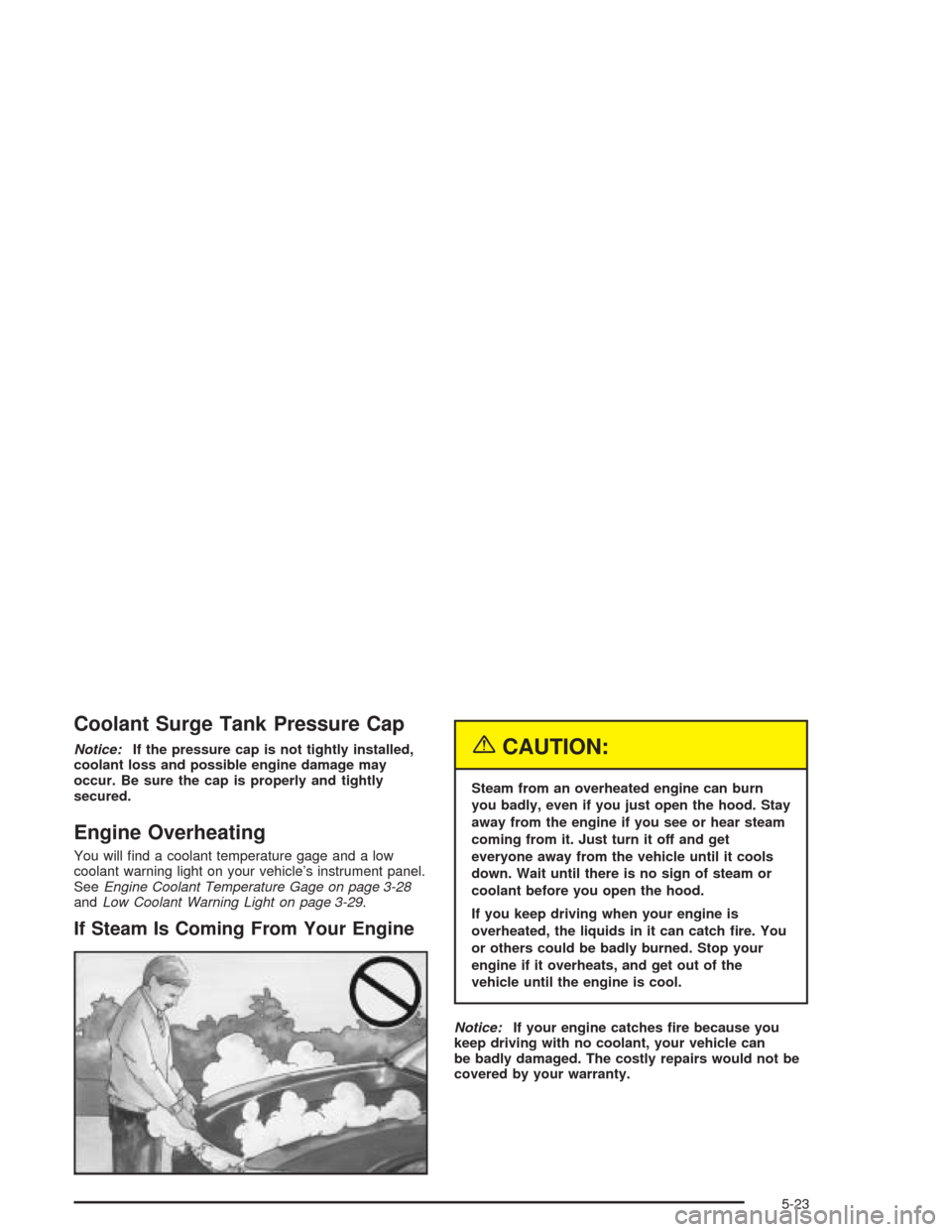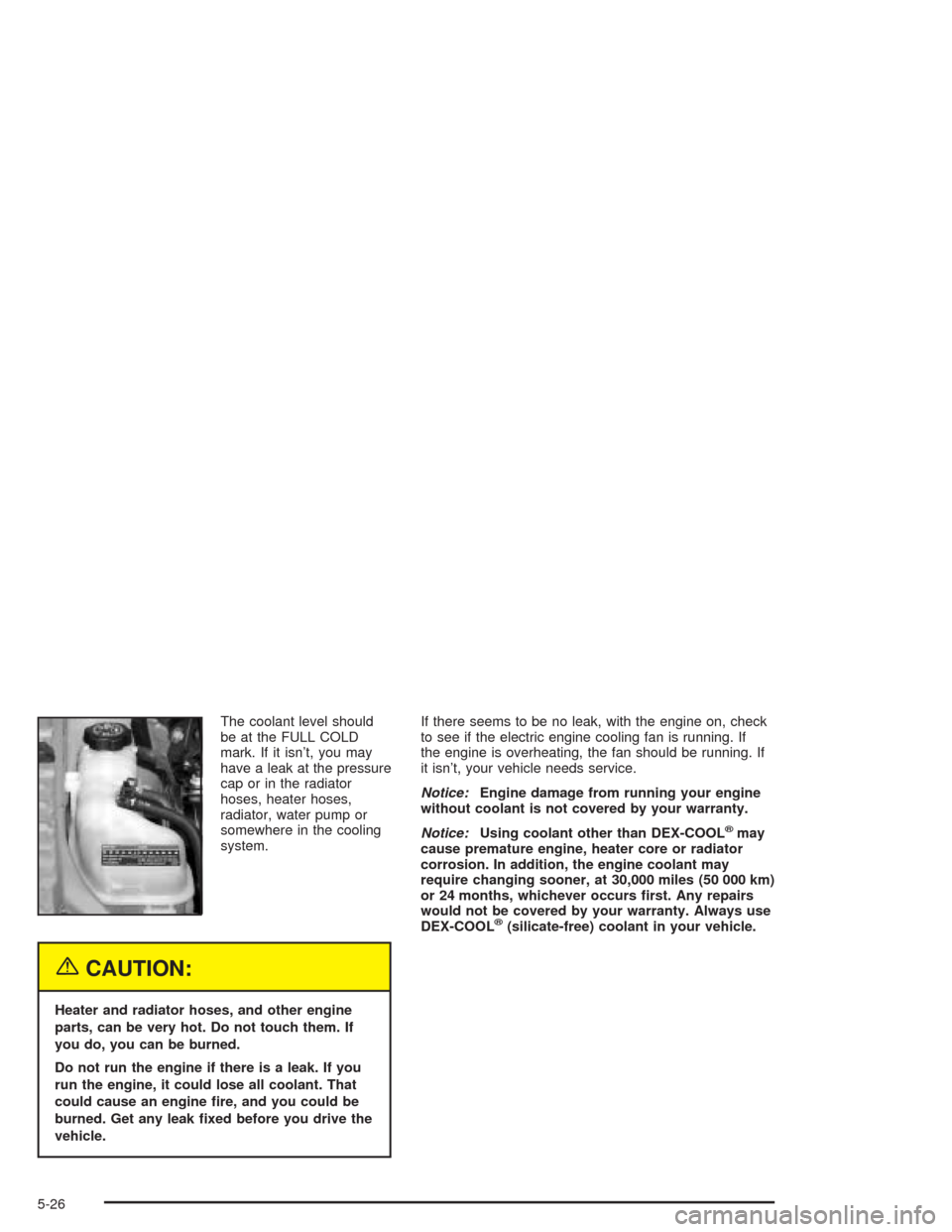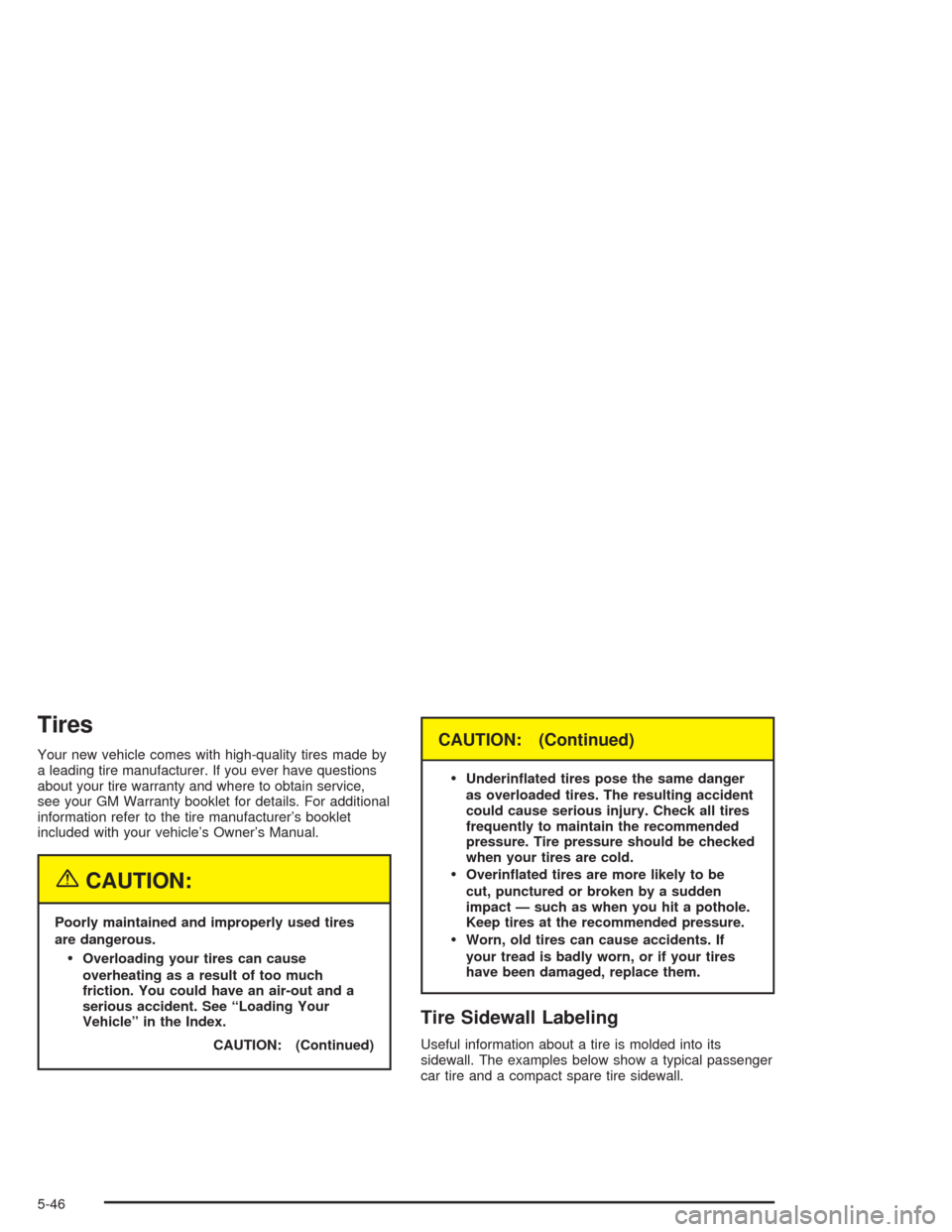Page 232 of 354

Checking Coolant
The surge tank is located
in the engine compartment
on the passenger’s side
of the vehicle. SeeEngine
Compartment Overview
on page 5-12for more
information on location.
{CAUTION:
Turning the surge tank pressure cap when the
engine and radiator are hot can allow steam
and scalding liquids to blow out and burn you
badly. Never turn the surge tank pressure
cap — even a little — when the engine and
radiator are hot.
The vehicle must be on a level surface. When your
engine is cold, the coolant level should be at the FULL
COLD mark.If the low coolant light
comes on and stays on, it
means you are low on
engine coolant. SeeLow
Coolant Warning Light
on page 3-29.
Adding Coolant
If you need more coolant, add the proper DEX-COOL®
coolant mixtureat the surge tank, but only when the
engine is cool. If the surge tank is empty, a special �ll
procedure is necessary. SeeEngine Overheating
on page 5-23for instructions on “How to Add Coolant to
the Coolant Surge Tank.”
{CAUTION:
You can be burned if you spill coolant on hot
engine parts. Coolant contains ethylene glycol,
and it will burn if the engine parts are hot
enough. Do not spill coolant on a hot engine.
When replacing the pressure cap, make sure it is
hand-tight.
5-22
Page 233 of 354

Coolant Surge Tank Pressure Cap
Notice:If the pressure cap is not tightly installed,
coolant loss and possible engine damage may
occur. Be sure the cap is properly and tightly
secured.
Engine Overheating
You will �nd a coolant temperature gage and a low
coolant warning light on your vehicle’s instrument panel.
SeeEngine Coolant Temperature Gage on page 3-28
andLow Coolant Warning Light on page 3-29.
If Steam Is Coming From Your Engine
{CAUTION:
Steam from an overheated engine can burn
you badly, even if you just open the hood. Stay
away from the engine if you see or hear steam
coming from it. Just turn it off and get
everyone away from the vehicle until it cools
down. Wait until there is no sign of steam or
coolant before you open the hood.
If you keep driving when your engine is
overheated, the liquids in it can catch �re. You
or others could be badly burned. Stop your
engine if it overheats, and get out of the
vehicle until the engine is cool.
Notice:If your engine catches �re because you
keep driving with no coolant, your vehicle can
be badly damaged. The costly repairs would not be
covered by your warranty.
5-23
Page 236 of 354

The coolant level should
be at the FULL COLD
mark. If it isn’t, you may
have a leak at the pressure
cap or in the radiator
hoses, heater hoses,
radiator, water pump or
somewhere in the cooling
system.
{CAUTION:
Heater and radiator hoses, and other engine
parts, can be very hot. Do not touch them. If
you do, you can be burned.
Do not run the engine if there is a leak. If you
run the engine, it could lose all coolant. That
could cause an engine �re, and you could be
burned. Get any leak �xed before you drive the
vehicle.If there seems to be no leak, with the engine on, check
to see if the electric engine cooling fan is running. If
the engine is overheating, the fan should be running. If
it isn’t, your vehicle needs service.
Notice:Engine damage from running your engine
without coolant is not covered by your warranty.
Notice:Using coolant other than DEX-COOL
®may
cause premature engine, heater core or radiator
corrosion. In addition, the engine coolant may
require changing sooner, at 30,000 miles (50 000 km)
or 24 months, whichever occurs �rst. Any repairs
would not be covered by your warranty. Always use
DEX-COOL
®(silicate-free) coolant in your vehicle.
5-26
Page 256 of 354

Tires
Your new vehicle comes with high-quality tires made by
a leading tire manufacturer. If you ever have questions
about your tire warranty and where to obtain service,
see your GM Warranty booklet for details. For additional
information refer to the tire manufacturer’s booklet
included with your vehicle’s Owner’s Manual.
{CAUTION:
Poorly maintained and improperly used tires
are dangerous.
Overloading your tires can cause
overheating as a result of too much
friction. You could have an air-out and a
serious accident. See “Loading Your
Vehicle” in the Index.
CAUTION: (Continued)
CAUTION: (Continued)
Underin�ated tires pose the same danger
as overloaded tires. The resulting accident
could cause serious injury. Check all tires
frequently to maintain the recommended
pressure. Tire pressure should be checked
when your tires are cold.
Overin�ated tires are more likely to be
cut, punctured or broken by a sudden
impact — such as when you hit a pothole.
Keep tires at the recommended pressure.
Worn, old tires can cause accidents. If
your tread is badly worn, or if your tires
have been damaged, replace them.
Tire Sidewall Labeling
Useful information about a tire is molded into its
sidewall. The examples below show a typical passenger
car tire and a compact spare tire sidewall.
5-46
Page 343 of 354

Driving (cont.)
Freeway.....................................................4-20
Hill and Mountain Roads..............................4-22
In Rain and on Wet Roads...........................4-16
Winter........................................................4-24
Driving on Grades...........................................4-42
Driving on Snow or Ice....................................4-25
Driving Through Deep Standing Water...............4-18
Driving Through Flowing Water.........................4-18
Driving with a Trailer.......................................4-40
E
Easy Entry Seat............................................... 1-6
Electrical System
Add-On Equipment......................................5-80
Fuses and Circuit Breakers...........................5-81
Headlamp Wiring.........................................5-80
Power Windows and Other Power Options......5-81
Windshield Wiper Fuses...............................5-81
Emergency Trunk Release Handle.....................2-11
Emissions Inspection and Maintenance
Programs...................................................3-31
Engine
Air Cleaner/Filter.........................................5-17
Battery.......................................................5-36Engine (cont.)
Check and Service Engine Soon Light............3-29
Coolant......................................................5-20
Coolant Heater............................................2-19
Coolant Temperature Gage...........................3-28
Cooling System Inspection............................6-23
Drive Belt Routing.......................................5-87
Engine Compartment Overview......................5-12
Exhaust.....................................................2-28
Oil .............................................................5-13
Overheating................................................5-23
Starting......................................................2-18
Engine Compartment Fuse Block......................5-84
Engine Coolant Level Check.............................6-18
Engine Cooling When Trailer Towing..................4-43
Engine Oil Additives........................................5-16
Engine Oil Level Check...................................6-18
Enhanced Traction System (ETS)........................ 4-8
Active Light................................................3-28
Warning Light.............................................3-27
Entry Lighting.................................................3-14
Event Data Recorders (EDR)............................. 7-9
Express-Down Window....................................2-13
Extender, Safety Belt.......................................1-28
Exterior Lamps...............................................3-11
5